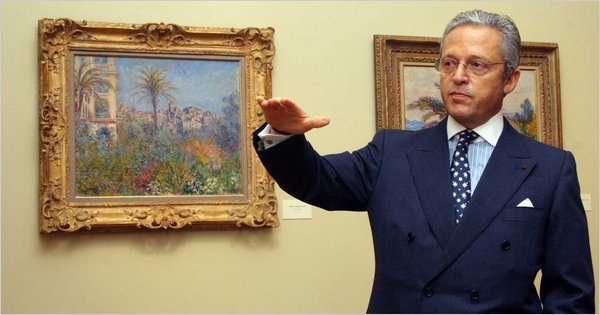The seizure of about 30 works has put an uncomfortable focus on the Wildenstein family, a discreet dynasty of French Jewish art dealers stretching back five generations whose name has long been one of the most prestigious in the international art world.
At the center of the current wave of troubles is Guy Wildenstein, 65, the president of Wildenstein & Company, an operation with spaces in New York, Tokyo and Paris. The family has faced controversies in the past, and lawsuits too, but never of the number or magnitude of those on the docket now. Mr. Wildenstein was summoned to Paris from New York to face questioning this week by French antifraud investigators who discovered the artworks while investigating money-laundering and tax evasion alleged in a criminal lawsuit against him.
Mr. Wildenstein, who holds dual French and American citizenship, is enmeshed in at least a half-dozen lawsuits; some, provoked by the raid, are being brought by heirs who claim the artwork was stolen from their families.
Also seeking answers is the Académie des Beaux-Arts, a prestigious French cultural society that has filed a legal complaint seeking an inquiry about a missing painting; Mr. Wildenstein’s father, Daniel, and grandfather Georges were elected members.
Mr. Wildenstein has declined to speak publicly about the inquiry or the suits. His newly hired spokesman in Paris, Matthias Leridon, said by telephone on Friday that Mr. Wildenstein “will not answer by using the media.”
“Let’s be calm and quiet and wait for the questions coming from the judges, and after he will express himself,” Mr. Leridon said, noting that Mr. Wildenstein has been called to answer questions at this point as a witness and not as a suspect.
In February, before hiring Mr. Leridon, Mr. Wildenstein issued a statement to the French magazine Le Point, after it published an article about the raids. The statement, which appeared in the magazine that month, said that the presence of the Morisot painting in the Wildenstein Institute vault could have been the “result of an error or oversight under my father’s operations.”
“In all serenity I will respond when the moment comes to the competent authorities,” he wrote in his letter to the magazine.
A Last Salvo
The flurry of legal attacks and the raid grew out of a criminal lawsuit filed in Paris in September by Mr. Wildenstein’s stepmother, Sylvia Roth Wildenstein, who, before she died in November, fired a last salvo in a fight stretching over almost a decade for a larger share of the inheritance from the estate of her husband, Daniel Wildenstein, who died in 2001. She accused Guy Wildenstein of tax evasion and money laundering to mask the size of the family fortune by shuffling, for example, the ownership titles of Impressionist paintings, including 19 valuable works by Bonnard, to anonymous trusts in the Bahamas and by storing art in a vault in Geneva beyond the reach of tax authorities.
Under the French legal system, criminal lawsuits are investigated by independent magistrates who are appointed by criminal judges and who have the power to gather evidence and refer the matter to courts for prosecution. Magistrates ordered the raid on the Wildenstein Institute, a nonprofit French organization founded by the family to conduct art research and publish catalogs tracking the work of prominent artists.
Five Generations
When the first branch of the Wildenstein Gallery opened in Paris in 1875, it quickly gained a reputation for selling old masters and 18th-century French painting and sculptures, and later for its impressive stock of Impressionist and Post-Impressionist paintings. The Wildensteins nurtured many of the world’s greatest collectors, including Baron Edmond de Rothschild and J. Pierpont Morgan, and prided themselves on sales to many major museums.
By 1942, they had begun to broaden their empire, opening a branch of the gallery in New York while the Germans occupied France, and later expanded to London and Buenos Aires. They produced, and in some cases wrote, catalogues raisonnés — the definitive records of particular artists’ works — for major figures including Monet, Manet and Gauguin, and in 1970 they established the institute, which focuses on research and arts philanthropy.
But the family’s business practices have sometimes been questioned sharply. After the war, the family resumed gallery operations in France, but stopped in the early 1960s after André Malraux, the French minister of culture, accused Georges Wildenstein of bribing a ministry official to permit the export of a Georges de La Tour painting. Mr. Wildenstein was never charged.
The family’s reputation came into question again in the 1990s, when the writer Hector Feliciano presented information in his book, “The Lost Museum: The Nazi Conspiracy to Steal the World’s Greatest Works of Art,” that during World War II Georges Wildenstein worked with an influential Nazi art dealer, Karl Haberstock, who bought and sold art plundered from Jews. Strongly disputing the charges, Guy Wildenstein and other family members pressed a defamation suit, ultimately unsuccessful, against Mr. Feliciano to France’s highest court. They did so after two lower courts ruled that Mr. Feliciano had not acted irresponsibly or negligently by drawing that conclusion from the records, though it said it could not rule on whether Georges Wildenstein had done business with the Nazis.
The Wildensteins’ latest crisis began last autumn when Sylvia Wildenstein, Guy’s stepmother, suffering from terminal ovarian cancer, was preparing to die. An American citizen born in Ukraine, she met Daniel Wildenstein in 1964 and was later married to him for 23 years, living a sumptuous life of diamonds and yachts, galas and racehorses, and luxurious homes in Paris and New York, graced with Monets and Bonnards.
But 15 days after her husband’s funeral in 2001, she declared in lawsuits against Guy and his brother, Alec, that they had convinced her that Daniel had died bankrupt and that she faced burdensome taxes, leading her to agree to renounce her inheritance rights in return for an apartment and 400,000 euros (about $570,000) in yearly income.
In 2005 the French courts restored her rights as an heir in a scathing decision, ordering her stepsons to pay her 20 million euros (about $28.5 million) as an advance on a fortune variously estimated from 43 million to 4 billion euros (about $61 million to $5.7 billion). The court observed that at nearly 70, a fragile Mrs. Wildenstein had been the “victim of a calculated error” to “induce her to renounce her husband’s estate.”
While the courts restored part of the fortune to Mrs. Wildenstein, the family continued sparring. Investigators acting under orders from the independent magistrate are looking into the tax allegations, but there is no public indication that tax authorities are doing the same, provoking questions in the French press about whether the administration of President Nicolas Sarkozy has been less aggressive than it should have been because Guy Wildenstein has close ties to Mr. Sarkozy’s Union for a Popular Movement party, which he supported as a top donor and chief fund-raiser from the United States.
In response to a question, a spokesman for the budget ministry last week declined to say whether an inquiry was under way, saying that in general such matters were confidential and that the ministry was “carrying on its work.”
The 10-year statute of limitations runs out on the tax evasion charges in December. Mrs. Wildenstein left specific instructions in her will to carry on the battle beyond the grave, according to her lawyer of seven years, Claude Dumont-Beghi, citing a line from her will that requested her heir and sister, Tamara Eskenazi, to continue following her lawyer’s legal strategy. But it is not clear what Ms. Eskenazi will do. A biblical scholar at the Hebrew Union College in Los Angeles, she did not respond to repeated messages and telephone calls from a reporter.
Multiplying Lawsuits
For many old French families the Wildensteins were more than dealers. They were trusted advisers and confidants with friendships that endured for generations. They offered discreet services and the use of their vaults to store valuable paintings when clients were away.
But descendants of those collectors said that this practice led to problems in tracking their holdings. “Collectors store their paintings in the vault like a bank, but there are problems when the art collector dies late in life,” said Serge Lewisch, a lawyer who represents two clients who have claims on artworks seized by investigators at the Wildenstein Institute.
Alexandre Bronstein, great-great-nephew of Julie Reinach, a wealthy art collector, has searched for years for works plundered from her collection in 1941 by the Nazis who torched the family home in St.-Germain-en-Laye. The police raid on the Wildenstein Institute uncovered a missing bronze by the Italian sculptor Rembrandt Bugatti and two Degas drawings that Mr. Bronstein said belonged to his family, and he promptly filed a criminal lawsuit inquiry.
He said he suspected there were more of his family’s missing artworks involved, and said the motivation for his lawsuit was basic: “People are lying, and we want to find the truth.”
Yves Rouart, nephew and heir of the art collector Anne-Marie Rouart, has been battling the Wildensteins in the French courts for years for the return of artworks from Mrs. Rouart’s collection after her death in 1993. She donated part of her collection and property to the Académie des Beaux-Arts, on the advice of Daniel Wildenstein. But she left her luxury apartment in Neuilly-sur-Seine, with its furnishings, to Mr. Rouart.
His legal pursuit began when he said that he had discovered that as many as 40 paintings — including works by Degas, Manet and the Morisot painting of the Normandy cottage — were removed from the walls during the settlement of her estate. Guy Wildenstein was one of the two executors. Twenty-four of those artworks, a Corot among them, turned up in Switzerland in 1997 in a Swiss safe rented by François Daulte, an Impressionist expert and the father of Olivier Daulte, another co-executor.
In the January raid on the Wildenstein Institute, another missing Morisot painting was discovered by the police, who alerted Mr. Rouart. He has filed a new criminal complaint — under the French legal system it is first filed against an unnamed person, “X” — while an inquiry determines how the painting came to be at the Wildenstein Institute. The Académie des Beaux-Arts filed a similar complaint involving the Morisot cottage painting in which it also claims an interest because of Mrs. Rouart’s donation.
“That particular painting has been in my family’s possession since its creation,” Mr. Rouart said. “My great-grandmother, my grandmother and father would never accept that this work would remain in the possession of a merchant who has no right to it.”
In his letter published in Le Point, Mr. Wildenstein said that in 18 years the painting had not been the subject of a claim and added, “I reject strongly any charges of other missing works in the vault from this collection.”
Mr. Wildenstein now also faces new litigation involving another Wildenstein widow. Jérôme Casey, a French lawyer, represents Liouba Wildenstein, the Russian wife of Guy’s brother, Alec Wildenstein, who died in 2008 of cancer.
“They treated her like a little girl and advised her just to listen to them,” said Mr. Casey, contending that Guy, along with Alec’s son, (also named Alec), pressured her to renounce her inheritance because of her potential tax burden.
“They really shocked her,” he continued. “They proposed a lump sum essentially, so that she would go back to Russia, and they wouldn’t have to hear from her again.”
The result was a new family bond: a lawsuit filed in February for breach of trust.




